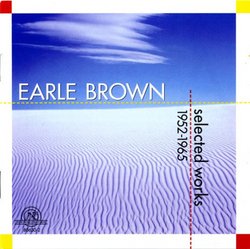| All Artists: violin); "Gerrit Oldeman", (viola); "Michael Daugherty" (piano, computer, electronics); "Dorothea von Albrecht" (cello); "Christine Olbrich" (piano); "Antoinette Vischer" (harpsichord); "George Gruntz" (harpsichord) "Earle Brown" (conductor); "Govert Jurr Title: Earle Brown: Selected Works 1952-1965 Members Wishing: 3 Total Copies: 0 Label: New World Records Original Release Date: 8/1/2006 Release Date: 8/1/2006 Genre: Classical Styles: Chamber Music, Historical Periods, Classical (c.1770-1830) Number of Discs: 1 SwapaCD Credits: 1 UPC: 093228065029 |
Search - violin); "Gerrit Oldeman", (viola); "Michael Daugherty" (piano, computer, electronics); "Dorothea von Albrecht" (cello); "Christine Olbrich" (piano); "Antoinette Vischer" (harpsichord); "George Gruntz" (harpsichord) "Earle Brown" (conductor); "Govert Jurr :: Earle Brown: Selected Works 1952-1965
 | violin); "Gerrit Oldeman", (viola); "Michael Daugherty" (piano, computer, electronics); "Dorothea von Albrecht" (cello); "Christine Olbrich" (piano); "Antoinette Vischer" (harpsichord); "George Gruntz" (harpsichord) "Earle Brown" (conductor); "Govert Jurr Earle Brown: Selected Works 1952-1965 Genre: Classical
This long-overdue reissue of the CRI recording of Earle Brown?s music is one of the best representations of his seminal works. ?It is obviously a great pleasure for me that CRI is re-releasing its 1974 recording of my ... more » |
Larger Image |
CD Details
Synopsis
Product Description
This long-overdue reissue of the CRI recording of Earle Brown?s music is one of the best representations of his seminal works. ?It is obviously a great pleasure for me that CRI is re-releasing its 1974 recording of my work, and an even greater pleasure that I am able to add to the repertoire. The performance of Times Five and Novara (recorded in Holland) still seem very fine representations of the works and are performed brilliantly by the Dutch musicians. December 1952 as realized by the late, brilliant pianist and composer David Tudor is, in my opinion, the best of many performances he made of this graphic score. It is fascinating to hear the realizations by Michael Daugherty of November 1952, December 1952 and Four Systems (all published in ?Folio? (1952?54)?immensely inventive and marvelously performed on piano, tape and computer, with the newer technology that was not available to Tudor at the time he recorded his version of December 1952. This recording of Nine Rare-Bits is one of six versions that Antoinette Vischer (who commissioned the work) and George Gruntz surprised me with when I returned to Basel after my lectures in Stockholm in 1965. Although I very specifically compose the sound events, it is an ?open-form? score, subject to innumerable formal shapes, arranged by the performers themselves. Music for Violin, Cello and Piano is a very early (1952) twelve-tone serial piece in very strictly metric notation. It uses Schillinger-suggested ?serial? techniques, very similar to Messiaen, as it turned out. In contrast, Music for Cello and Piano is a completely subjectively composed work, in what I called ?time notation? (contrary to metric?) which is now referred to as ?Proportional Notation.? I feel this recording to be an extremely authentic and artistically fulfilled representation of these works written between 1952 and 1965 (not all that I wrote during that time, I hasten to add). I hope that future recordings will as successfully represent my work written between 1965 and 2050 as this does the early work.? ? Earle Brown, January 29, 2000 (from the original liner notes)

 Track Listings (10) - Disc #1
Track Listings (10) - Disc #1